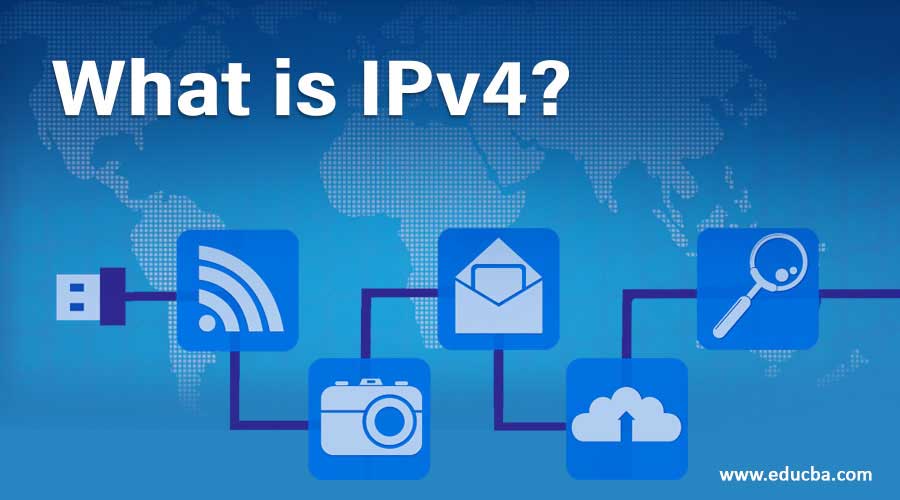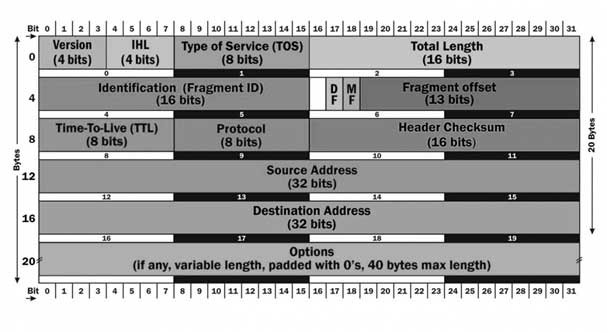Updated March 18, 2023

Introduction to IPv4
IPV4 is internet protocol version 4, which is used in the IP layer of the TCP/IP protocol suite to identify each device connected to the internet. IPV4 address is unique and universal, 32 bit long having address space of 2^32 or 4,294,967,296, use three notation to show address, binary notation(base 2), hexadecimal notation (base 16), dotted decimal notation (base 256). IPV4 packet header consists of 14 fields in which 13 fields are required, and 14 were optional.
Examples of IPv4
Following are the examples of IPv4:
The IP address 105.249.119.16 represents the 32-bit decimal number and in Binary is:
01101001.11111001.01110111.00010000.
- It is used in packet switch networks for uninterrupted networking.
- It has a standardized format to deliver information from one device to another, which is connected through the internet.
- Identification is provided for each device that is connected between networks.
- There are configuration methods for each device, and it also varies on network types.
- IPv4 has defined in 32-bit (4 bytes) addresses, and it uses 3 classes: A, B, C.
- Class A is used for larger networks. It uses 8 bits for networking and 24 bits for hosting.
- Class B is used for medium networks. It uses 16 bits for networking and 16 bits for hosting.
- Class C is used for smaller networks. It uses 24 bits for networking and 8 bits for hosting.
- Additionally, Class D is used for multicasting, and Class E is used for experimental purposes.
1. IP Addresses
Internet Protocol address (IP address) is a numerical label assigned to a device connected to a network that uses the Internet Protocol for communication. The internet layer passes the IP address of the next-hop address to the network layer. This address is bounded to a physical address, and a new frame is formed. The rest of the original frame is encapsulated in a new frame before sent over the communication channel. The network layer stands as the OSI model’s backbone and manages the best logical path for data transfer between nodes.
‘Generally, it is made up of binary values and drive the routing of all data over the internet’.
The IP address has 2 main functions:
- Host/Network interface identification
- location addressing
2. IANA
The IANA (Internet Assigned Numbers Authority) and by 5 RIRs (Regional Internet Registries) manage IP address space. They are responsible for designated territories for assignment to local internet registries such as Internet service providers and other end users. And such assignments may be static or dynamic in basis depending upon network practices and software features.
IPv4 Datagram Header
Following is a diagrammatical explanation of the datagram header:
Given below is the IPv4 datagram header in the tabular format below:
| Version | This is a 4-bit field, and it tells the version of IP we are using. |
| HLen | It gives the length of the header. The minimum header length should be 20 bytes, as the maximum header size of 4 bits is 15. If we use the options field, 60 Bytes(20+40) will be the maximum header length. |
| Type of Service | The first 3 bits tell the precedence, and the next 4 bits tell the type of service, and the last bits are not used. The 4 bits of services define the delay, throughput, reliability, cost. |
| Total Length | The total length field defines the total length of the datagram, including the header. Total length can be calculated as data length + header length or data length = total length – header length of 16 bits. |
| Identification (Fragment ID) | As IPv4 is a datagram service, these bits help to identify uniquely when fragmentation is over on datagram packets. |
| Flags | The flag indicates the fragmentation using the identification field, basically tells whether it can be fragmented or the current one is the final one. |
| Fragment Offset | The neighbour Position of every fragment is measured from the original data’s beginning by units of 8 bytes. |
| Time to Live | This helps to misguide the transactions of datagrams. It measures the no.of.routers that can datagram pass through. It checks by decrementing the value to 1 till it reaches 0. Datagram gets discarded when it reaches zero. |
| Protocol | IPv4 contains data from various protocol. This field helps the network layer to understand which data belongs to which protocol. |
| Header Checksum | This field is used to detect errors in the packets or messages. |
| Source IP Address | 32-bit address of the sending host. |
| Destination Ip Address | 32-bit address of the receiving host. |
| Options | Every datagram doesn’t specify the option field. It is the list of specifications that contains security restrictions, routing, etc. |
Limitations
Given below are the limitations mentioned:
- Lack in Address Space: Address space gets quickly depleted as the number of devices connected to the Internet grow rapidly.
- Weak Protocol Extensibility: Insufficient size of IPv4 header, does not accommodate required no.of.additional parameters.
- Security Limitation Problem for Communications: Information does not have limit access that is hosted on the network. Originally designed for isolated military networks. Then adapted for public education & research network.
- Lack of Quality In-Service Support: Delay in information’s bandwidth and certain networks does not support for this reason.
- Geographic Limitations: As it was created in the USA, it involves in distribution of IP address, and almost 50% are reserved for the United States.
Benefits
Given below are the benefits mentioned:
- Reliable Security: This address packet has data encryption to maintain privacy & security during public medium communication.
- Large Routing Tasks: The high amount of functional routers makes this as Internet backbone, and thus it has vital network allocation. Infrastructure is dependent on both hierarchical & flat routing. It also becomes easy to connect multiple devices across a large network without NAT.
- Video Libraries and Conferences: Increased number of internet users slow down online data transfer. This model of communication provides quality service & efficient data transfer. TCP & UDP services are used in most cases; despite limited functionality, IPv4 addresses are redefined & allows data encryption.
- Flexibility: IPv4 routing is more scalable & efficient as addressing are aggregated. Specifically, it works well for multicasting & data communication across networks in an organization.
Usage of IPv4
The address allocations are established in 5 RIRs with its IP addresses:
- African Network Information Center (AFRINIC): Serves in Africa and portions of the Indian ocean.
- American Registry for Internet Numbers (ARIN): Serves in Canada, parts of the Caribbean, and the United States, North Atlantic islands also.
- Asia-Pacific Network Information Centre (APNIC): Serves in most of Asia and Oceania.
- Latin America and Caribbean Network Information Centre (LACNIC): Serves in Latin America and portions of the Caribbean.
- Reseaux IP Europeens Network Coordination Centre (RIPE NCC): Serves in Europe, Central Asia, and the Middle east.
These regions are responsible for IP address allocations to operators & internet users within that region. The RIR’s have depleted in no of IPv4’s because of the shortage of IP address allocations. To counter the shortage of IP addresses and widen the usage of addresses in communication to access efficiently, IPv6 was created. Due to address exhaustion in IPv4, IPv6 was created with increased infrastructure design and capacity to handle the payload.
Recommended Articles
This is a guide to What is IPv4? Here we discuss the introduction to IPv4 and the datagram header and its limitations, benefits, and usage. You may also look at the following articles to learn more-


